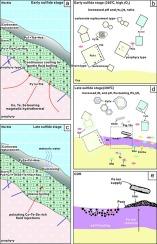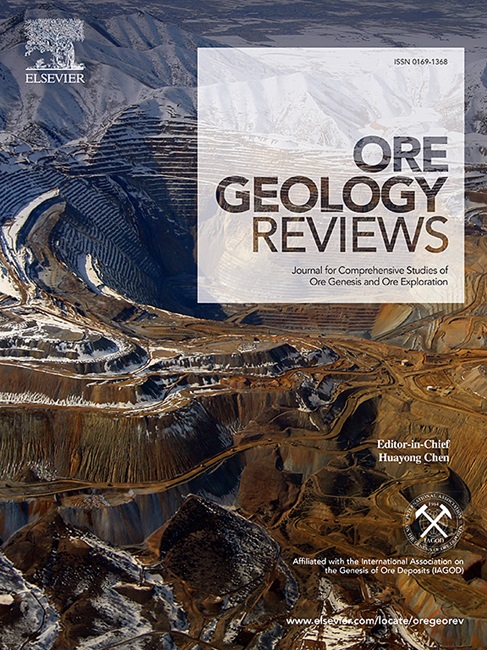Distribution of Co, Te, Se in porphyry copper systems: A case study of the Tonglvshan deposit, Eastern China
IF 3.2
2区 地球科学
Q1 GEOLOGY
引用次数: 0
Abstract
Porphyry copper systems contain porphyry Cu, skarn, carbonate-replacement and epithermal deposits, and presently supply nearly all the Te and Se, and have the potential to produce Co as by-product in the future. However, few studies have investigated the distribution of Co, Te, and Se in the specific porphyry-skarn deposit. Detailed mineralogical and geochemical analyses were conducted to investigate the distribution of Co, Te, and Se across porphyry, skarn, and carbonate-replacement ore types in the Tonglvshan porphyry-skarn Cu-Fe-Au deposit, Eastern China. The early sulfide stage in three ore types is characterized by Co-bearing pyrite (Py1a, Co up to 1.3 wt%) + droplet-like tetradymite ± hessite ± cattierite. The texture transition from coarse-grained, pore-free to porous Py1a in porphyry and skarn type ores suggests a shift from stable physico-chemical conditions to gentle fluid boiling, resulting in the precipitation of Co- and Te-bearing minerals. In contrast, fine-grained euhedral Py1a in carbonate-replacement type ores implies rapid cooling from high-temperature fluid interaction with marble.
The late sulfide stage, which only occurs in skarn and carbonate-replacement type ores, is characterized by Co-rich pyrite (Py2) + carrollite + hessite + Bi-sulfosalts. In skarn type ores, tetradymite-kawazulite solid solution (TKSS) + hessite + native Te + naumannite reflects intense boiling, leading to an increase in fO2 and pH that precipitates Py2b (Co up to 19.2 wt%) and carrollite, while Te and Se may precipitate through vapor phase condensation. Conversely, the presence of fine-grained carrollite, zoned Py2a, sphalerite, and galena in carbonate-replacement type ore suggests that rapid cooling and increasing pH, resulting from fluid mixing, played a significant role in the precipitation Co and Te. Furthermore, the porous texture resulting from coupled dissolution-reprecipitation (CDR) during the late sulfide stage also provided favorable conditions for the formation of micro-nano sized critical metal particles.

斑岩铜系统中钴、碲、硒的分布:中国东部铜绿山矿床案例研究
斑岩铜系统包括斑岩铜、矽卡岩、碳酸盐置换和热液矿床,目前几乎提供所有的碲和硒,并有可能在未来生产副产品钴。然而,很少有研究调查特定斑岩-矽卡岩矿床中钴、碲和硒的分布情况。为了研究中国东部铜绿山斑岩-矽卡岩铜-铁-金矿床中钴、碲和硒在斑岩、矽卡岩和碳酸盐置换矿石类型中的分布,我们进行了详细的矿物学和地球化学分析。三种矿石类型的早期硫化物阶段的特征是含钴黄铁矿(Py1a,钴含量高达 1.3 wt%)+水滴状四铁矿±辉绿岩±猫铁矿。斑岩型和矽卡岩型矿石中从粗粒、无孔到多孔 Py1a 的质地转变表明,从稳定的物理化学条件转变为温和的流体沸腾,导致含 Co 和 Te 的矿物沉淀。与此相反,碳酸盐置换型矿石中的细粒八面体Py1a意味着高温流体与大理岩相互作用后的快速冷却。晚期硫化物阶段仅出现在矽卡岩型和碳酸盐置换型矿石中,其特征是富钴黄铁矿(Py2)+卡罗来石+辉锑矿+双硫化物。在矽卡岩型矿石中,四闪长岩-卡瓦祖利石固溶体(TKSS)+红柱石+原生碲+瑙锰矿反映出强烈的沸腾,导致 fO2 和 pH 值升高,从而沉淀出 Py2b(钴含量高达 19.2 wt%)和卡罗莱石,而碲和硒则可能通过气相凝结沉淀出来。相反,碳酸盐置换型矿石中存在细粒榴辉岩、带状Py2a、闪锌矿和方铅矿,这表明流体混合导致的快速冷却和pH值升高在Co和Te的沉淀中起了重要作用。此外,硫化物晚期阶段的溶解-再沉淀耦合作用(CDR)所产生的多孔质地也为微纳尺寸临界金属颗粒的形成提供了有利条件。
本文章由计算机程序翻译,如有差异,请以英文原文为准。
求助全文
约1分钟内获得全文
求助全文
来源期刊

Ore Geology Reviews
地学-地质学
CiteScore
6.50
自引率
27.30%
发文量
546
审稿时长
22.9 weeks
期刊介绍:
Ore Geology Reviews aims to familiarize all earth scientists with recent advances in a number of interconnected disciplines related to the study of, and search for, ore deposits. The reviews range from brief to longer contributions, but the journal preferentially publishes manuscripts that fill the niche between the commonly shorter journal articles and the comprehensive book coverages, and thus has a special appeal to many authors and readers.
 求助内容:
求助内容: 应助结果提醒方式:
应助结果提醒方式:


